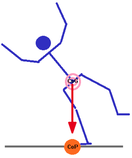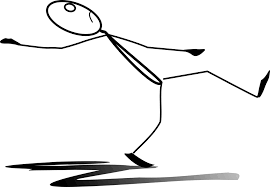 What, exactly, is balance? It’s “the state of having your weight spread equally so that you do not fall”.(1) Think about it like this: it’s your centre of gravity over your base of support. That’s why four-legged creatures have an easier time maintaining balance on slippery surfaces: they have a lower centre of gravity and a wider base of support. We all need good balance to safely move around our world on a daily basis, but have you ever thought about it? If you’ve ever lost your balance, fallen and sustained an injury, you get it. Balance is a critical component of walking - because walking is essentially a weight transfer and balance exercise. One foot, then the other. Repeat. If you’re having trouble with balance, how will you be with walking? Well, walking will also be difficult, and that’s when you’re most likely to risk a fall. If balance is a challenge for you, you’re likely more aware of its importance. The ability to maintain an upright position without falling over — it’s cute when a toddler is learning to walk unaided. A young child falls regularly, but over time, their balance improves and they fall less. As adults, poor balance can be life-threatening and, frankly, quite frightening. As we age, our balance is impacted negatively by our aging bodies: - cells die in our vestibular system, which is connected to the centre in our brain that controls balance, - our vision declines and with it, our depth perception, - changes to our blood pressure may cause dizziness, lightheadness or blurriness, - we lose muscle mass, strength, and power — this can slow our reaction time if we trip, - our reflexes and coordination also decline, and - a variety of health problems may also impact our balance, including arthritis, stroke, Parkinson’s disease and multiple sclerosis.(2) So, how is your balance? Did you know it’s actually one of your senses?(3) The myth that we have only 5 senses - sight, taste, touch, feeling, & hearing - can be traced back to Aristotle. But scientists know that we have many more than five. These include the sense of movement, temperature, hunger, thirst, pain, balance, and proprioception. Fitness professionals in the functional fitness realm regularly refer to proprioception - your ability to sense where the parts of your body are without seeing them. You know, how you can get up in the dark and walk to your bathroom without falling over. And think about a law-enforcement official asking you to close your eyes and touch your nose as a sobriety test. That’s proprioception! Regular physical activity is key to maintaining good balance. An exercise program that focuses on specific balance exercises as well as core strengthening and movement patterns will improve balance and stability, not to mention daily function.
- Test yourself: set a timer and stand on one leg; repeat on the other side (this is your baseline) - Check your feet/remove your shoes to engage proprioception - Bend your standing leg to lower your centre of gravity - Focus on a static point (e.g., during class, not me, but a point above my head) - Think about your joints, making them as light as possible - Slight pelvic tilt, engage the abs - If in doubt, reset by lowering your leg to the ground - Airplane arms out to the side to increase your base of support - Stand near a wall/chair or gently touch a wall/chair with your hand - Need more help? Sign up for one of my online courses, “3 Days to Better Balance” or “Balance 2.0” Balance Courses What’s on your bucket list? Are you missing out on life? Has a fear of falling or a past fall impacted how and when you go out? As we get older, the risk of falls that can injure us increases. As a result, individuals like you curb their activity levels. But it doesn’t have to be that way. If you take ownership of your body, you can be as active as you like. Working on improving your balance and strengthening your muscles will increase your confidence and reduce the risk of a fall. So you can get back to enjoying your life, and continue to tackle that bucket list. Your body was designed to last a lifetime; but you need to use it daily for lasting effects. I have created online courses that can help: “3 Days to Better Balance” and “Balance 2.0: Progressions in Motion”. Both include daily videos with exercises and instructions on how to use more muscles in daily life. You’ll also receive daily check-ins with me via email or text message - this will help keep you on track with your goals. Here’s some feedback from participants completed my online balance courses: “I found as I stood at the sink doing my teeth, and at the bus stop, being very aware of my standing base.” “Wow so great for my unconscious winter hunched shoulders’ posture!” “I really needed the 3 Day Balance work. It was great.” A. How often do you walk sideways? It’s a great way to strengthen your inner and outer thighs - aka, your adductor and abductor muscles. Sideways walking can help improve your balance, by strengthening these smaller stabilizing muscles. And it’s great brain training too - since we don’t typically walk sideways, your body and brain have to exert more effort to move.
B. Backwards walking to improve your balance? You betcha! It’s important to rely on more than just your eyes when you’re moving around in life. Walking backwards helps you improve your proprioception, by relying on the input from your feet. It’s also strengthening your brain-body connection by creating new pathways in your brain. AND improving coordination in the lower half of your body.
1 Comment
|
Categories
All
Archives
July 2024
AuthorAmanda Sterczyk is an international author, Certified Personal Trainer (ACSM), an Exercise is Medicine Canada (EIMC) Fitness Professional, and a Certified Essentrics® Instructor. |

 RSS Feed
RSS Feed